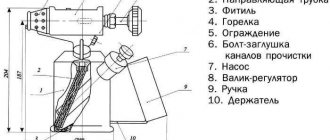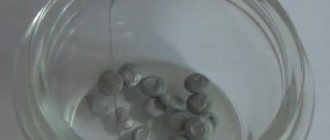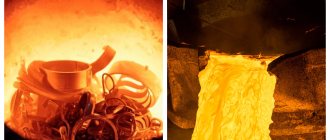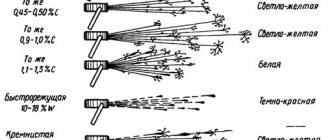A blowtorch is a necessary tool when working with metal. A blowtorch will help resurrect a household appliance, telephone, or electronic device. The device solders metal parts and quickly removes paint and varnish coatings from a metal surface. A blowtorch can only be used in working condition.
Do not forget that the tool is connected to the electrical network. A defect in functionality can cost the master his health. Experts tell us how to repair blowtorch malfunctions with your own hands.
The most common malfunctions and causes of failure
The most common malfunctions of a blowtorch are as follows:
- the pressure required for normal operation is absent or rapidly decreasing in the housing;
- there is no flame due to the fact that the fuel stream from the injector does not meet the required parameters;
- fuel leaks through joints and seals;
- Instead of spraying, a stream flows out of the nozzle.
Some problems can be fixed if you have the necessary tools at hand. Typically, repair work consists of cleaning individual components.
Sometimes the breakdown is so serious that it is impossible to repair the tool without the spare parts used for the blowtorch. Fortunately, you can find many repair kits in hardware stores and on specialized websites on the Internet.
The reason for the lack of pressure in the lamp may be a faulty pump. It can be replaced or repaired with your own hands. A rapid decrease in pressure occurs if the threaded connections, service and safety valves are leaking.
The problem is solved by replacing the gaskets, cleaning the surfaces of the covers and valves in contact with the body.
There is no burner flame if the fuel stream coming from the nozzle is very weak or intermittent. This can occur due to contaminants that have entered the lamp with low-quality fuel. In this case, it is necessary to clean all the channels and the jet with suitable tools and rinse the lamp with clean gasoline.
Fuel leaks through the seals of the control valve if the stuffing box, which is the sealing gasket between the body and the valve, has lost its properties. Repairing the malfunction involves disassembling the tap and replacing the stuffing box.
If fuel streams out of the burner, the reason is most likely that the nozzle opening is not correct. Before this, you need to make sure that the instrument is really warmed up. If problems of this kind recur during warm-up, the burner nozzle must be replaced.
Essential repair tool
The following tools may be required for repairs:
- adjustable wrench;
- screwdrivers;
- pliers;
- small brush;
- sewing needle or thin steel wire.
Materials you may need include stuffing box, steel washers and nuts, gasoline or kerosene.
You will need to disassemble the tool and its components with a wrench and screwdrivers to provide access to the faulty part. You will need pliers if you have to hold the needle to clean the nozzle hole without disassembling the burner. In addition, it is convenient to use pliers to hold any screws from turning during assembly and disassembly. A brush is necessary to wash away contaminants that have entered the body and burner. It is advisable that the brush be long with hard natural bristles.
Pump repair
The blowtorch pump consists of a piston enclosed in a metal housing and a spool, which is installed at the end of the piston tube and operates on the principle of a check valve. It lets air into the body and does not let it back out.
At the end of the piston there is a leather cuff that pushes air when moving inside the lamp, and folds up to let air through when moving in the opposite direction.
This piece is simply a circle of leather sandwiched between two steel washers of different diameters. The upper washer is almost equal in diameter to the diameter of the cylinder, and the lower one is several millimeters smaller. Thanks to this, the cuff is able to pump air, folding only in one direction when necessary. To increase the service life of the cuff from repair to repair, it must be lubricated occasionally with thick lubricant.
Most often, the spool or cuff is faulty. Repairing a blowtorch pump will involve replacing them with serviceable ones. The best option for repairs would be to take working spare parts from a non-working old blowtorch, if possible. If you cannot find them, you will have to buy these parts.
The cuff, however, can be cut from a suitable piece of leather or from any suitable cuff for another pump.
A little about making leather cuffs for Primus stoves
Posted by Manuel · 04/10/2016 08:32
4,634 views
Often in old Primus stoves, due to their venerable age, the leather pump cuff is one of the parts susceptible to destruction.
A few words about how to make a new knee cuff. Dimensions are given for the Tula Primus pump with an internal sleeve diameter of 18 mm.
1. Cut out a circle the size of a two-ruble coin from leatherette, or preferably from genuine leather 2 mm thick. The PVC coating must be removed with sandpaper.
2. Use a punch to punch a hole with a diameter of 5 mm in the center.
3. We clamp the resulting “washer” on the M5 pin, with the “shaggy” side inside the molded cuff. It is better to take an M5 washer with a “shaggy” side with a diameter of 9.10 mm.
4. Dip the pin together with the workpiece into melted paraffin and leave it there for 15-20 seconds for impregnation. You should not wait longer than this time, because the leatherette blank becomes rigid and inconvenient for further molding.
5. First molding on a die with an internal diameter of 20 mm.
6. Second molding on a die from a tube with an internal diameter of 17.5 mm. It is necessary to keep the workpiece in the tube until it cools completely. If there is no tube, you can use the pump sleeve as a mandrel, after removing the burrs.
7. Holding the workpiece by the pin, use a sharp knife to trim the uneven edges along the cut of the tube.
9. Using a punch with a diameter of 8.9 mm, punch a hole in the workpiece.
10. That's it! The cuff is ready!
The pump is assembled in the following order:
1. The handle is screwed onto the rod and the pump cover is put on.
2. At the place where the transition from a diameter of 6 mm to a diameter of 5 mm begins, a little cotton soaked in oil is wound. thread This is necessary to prevent air leakage.
3. The pump washer is put on; the side facing the cuff should have a smooth, burr-free surface. This is also necessary to prevent air leakage.
4. Next, a piece of brass tube is put on.
5. A cuff is placed on the brass tube. The cuff should sit loosely on the brass tube, the gap is 0.3. 0.5 mm. This is necessary for active filling of the sleeve with air during the reverse stroke of the rod.
6. An M5 nut with “flat spots” is screwed onto the thread of the rod.
7. The nut with “balts” is locked with a regular nut.
8. The cuff and rod are lubricated with semi-liquid oil. I used a compressor.
9. The assembled structure is inserted into a lightly lubricated sleeve. A test pumping is carried out.
Handling old lamps
Old blowtorches that have not been used for a long time should first be inspected from the outside. During inspection, you need to check how easily all the valves and the tank lid open. The adjustment valve should turn easily.
After this, you need to check the housing for leaks. To do this, use a pump to pump air into a lamp that is not filled with fuel. Then, using a brush, apply a thick soap solution to all threaded connections and the faucet. You need to check it closed and open.
If all connections are tight and the pump is properly creating pressure in the housing, the tap performs its functions by opening and closing the burner, the lamp can be refilled and started.
Despite the fact that the design of the blowtorch is simple, it also has problems that interfere with normal operation. And if there are some malfunctions, it is prohibited to use a blowtorch. But in most cases, repairs are easy to do yourself, which will eliminate downtime and make the tool safe to use.
If there are problems with the supply of fuel and air mass
In this case, prepare a straight-head screwdriver, pliers, a needle and thin wire. A fuel supply problem is detected by the appearance of foam and its seepage through the base of the nozzle. Most likely the jet is clogged.
Repair work involves the following sequence of manipulations:
- If there is a visible small gap, carefully insert the needle into the calibration recess and clean the fuel tube with it.
- If a positive result is not expected, the nozzle is removed.
- The wire is placed in the hole of the fuel pipe.
- Next, unscrew the valve.
- Pour gasoline into the channel. Perform the manipulation carefully and slowly.
- Assemble the structure into a single whole, put the jet in place.
- If flames appear from under the stem, extinguish the fire.
- Remove the valve handle and replace the worn stuffing box in the intake needle with a new one.
If the air pressure on the inner surface of the chamber in a blowtorch is broken, repairs are carried out based on the channels that function to supply an air stream. The technician should remove carbon deposits by filling the channels with trichlorethylene. Afterwards, to wash away the rust formed on the walls, rinse the channels with acid and dry by blowing with compressed air.
The work is carried out wearing special gloves. It is also better to protect your eyes with glasses.
You can watch video instructions on how to repair a blowtorch with your own hands: How to avoid regular repairs
In order to resort to repairing a blowtorch infrequently, you must follow the instructions for using the unit. We are used to turning on a blowtorch indoors. But then you should remember that the tool should be in working condition for no longer than 15-30 minutes. After use, the room is thoroughly ventilated.
You can extend the life of your equipment by applying the following rules:
- Before turning on the device, fill it with fuel. Refueling is carried out by filling the tank to ¾ of the total volume. Emptiness is necessary to create pressure.
- For pressure to be present, the pump also needs to make 10 gentle pumping motions.
- When pouring fuel into the burner tray, use an alcohol composition. Thanks to this technique, a minimal amount of soot is formed. Correct operation of the unit is possible if the fuel is ignited. There should be no drafts around.
- When fuel combustion is complete, open the needle valve. The fuel is now in a gaseous state. If drops are present, continue heating. If the burner does not heat up for a long time, place the lamp near a metal panel. Maintain a distance of 2-3 cm from the sheet to the nozzle.
- If the combustion goes out, clean the nozzle with a special needle.
- You can extinguish the torch of the instrument by screwing the valve and lowering the needle.
- Do not turn on a blowtorch near the burner. This provokes heating of the cylinder and fuel beyond 50 degrees.
- The fuel that is poured into the equipment must meet the specifications established by the blowtorch manufacturer.
Despite the fact that the design of the blowtorch is simple, it also has problems that interfere with normal operation. And if there are some malfunctions, it is prohibited to use a blowtorch. But in most cases, repairs are easy to do yourself, which will eliminate downtime and make the tool safe to use.
The most common malfunctions and causes of failure
The most common malfunctions of a blowtorch are as follows:
- the pressure required for normal operation is absent or rapidly decreasing in the housing;
- there is no flame due to the fact that the fuel stream from the injector does not meet the required parameters;
- fuel leaks through joints and seals;
- Instead of spraying, a stream flows out of the nozzle.
Some problems can be fixed if you have the necessary tools at hand. Typically, repair work consists of cleaning individual components.
Sometimes the breakdown is so serious that it is impossible to repair the tool without the spare parts used for the blowtorch. Fortunately, you can find many repair kits in hardware stores and on specialized websites on the Internet.
The reason for the lack of pressure in the lamp may be a faulty pump. It can be replaced or repaired with your own hands. A rapid decrease in pressure occurs if the threaded connections, service and safety valves are leaking.
The problem is solved by replacing the gaskets, cleaning the surfaces of the covers and valves in contact with the body.
There is no burner flame if the fuel stream coming from the nozzle is very weak or intermittent. This can occur due to contaminants that have entered the lamp with low-quality fuel. In this case, it is necessary to clean all the channels and the jet with suitable tools and rinse the lamp with clean gasoline.
Fuel leaks through the seals of the control valve if the stuffing box, which is the sealing gasket between the body and the valve, has lost its properties. Repairing the malfunction involves disassembling the tap and replacing the stuffing box.
If fuel streams out of the burner, the reason is most likely that the nozzle opening is not correct. Before this, you need to make sure that the instrument is really warmed up. If problems of this kind recur during warm-up, the burner nozzle must be replaced.
Essential repair tool
The following tools may be required for repairs:
- adjustable wrench;
- screwdrivers;
- pliers;
- small brush;
- sewing needle or thin steel wire.
Materials you may need include stuffing box, steel washers and nuts, gasoline or kerosene.
You will need to disassemble the tool and its components with a wrench and screwdrivers to provide access to the faulty part. You will need pliers if you have to hold the needle to clean the nozzle hole without disassembling the burner. In addition, it is convenient to use pliers to hold any screws from turning during assembly and disassembly. A brush is necessary to wash away contaminants that have entered the body and burner. It is advisable that the brush be long with hard natural bristles.
Cleaning the jet
The jet, as already mentioned above, can either become clogged with dirt from low-quality fuel, or carbon deposits from its combustion. In both cases, cleaning can correct the situation. If you need to use the lamp very urgently, you can try to clean the nozzle with a needle held in pliers. But in this case, contaminants will get inside. Immediately after completing the work, it is necessary to disassemble and clean the entire blowtorch.
If there is no hurry, it is better to unscrew the jet from the burner and try to blow it with compressed air from a compressor or from a special can. Only if this method does not produce results, you can carefully use mechanical cleaning during repairs.
After cleaning the nozzle, it must be washed in gasoline and dried before installing it in the burner.
Don't forget about safety
- It's time to remember about safety! I can’t count how many fires the blowtorch has caused. Let's not “multiply the exploits” of past generations and act correctly:
- if you have to work in a room with walls or floors made of flammable materials, then you will have to use metal or asbestos sheets;
- the gasoline canister should be placed so far away that an open flame does not touch it under any circumstances;
- Yes, we all spill gasoline when refueling a lamp, you will have to collect it with sand or rags and take it further from the place of work;
- no twisting of electrical wires nearby or any sparking tools with brushes;
- You are not supposed to use a blowtorch in the wind, since both gasoline and flames can fly away anywhere.
Handling old lamps
Old blowtorches that have not been used for a long time should first be inspected from the outside. During inspection, you need to check how easily all the valves and the tank lid open. The adjustment valve should turn easily.
After this, you need to check the housing for leaks. To do this, use a pump to pump air into a lamp that is not filled with fuel. Then, using a brush, apply a thick soap solution to all threaded connections and the faucet. You need to check it closed and open.
If all connections are tight and the pump is properly creating pressure in the housing, the tap performs its functions by opening and closing the burner, the lamp can be refilled and started.
A blowtorch, as a device for performing a variety of repair and construction work, is still in wide demand. Their popularity is due to their compactness, ease of use, and, subject to proper operation, also safety. We will discuss below how to work with the lamp correctly and maintain it on time.
Device
A gasoline blowtorch consists of the following components:
- A burner designed to use a specific type of fuel. For example, a gas blowtorch will have a different burner design than a device using liquid fuel.
- Fuel tank.
- Systems for supplying the combustible mixture to the burner.
- Manual fuel supercharger (pump).
- Shut-off and control device.
- Check valve (not available in all designs).
- Holding handle.
To achieve compactness, the booster pump is located directly in the tank. Before use, the user should pump the pump several times to create the required vacuum level: then the fuel will flow to the regulator.
The fuel supply system is extremely simple, and works on the principle of a locking needle: when such a needle moves in the cross section of the regulator, the pressure of the mixture changes, which determines a certain rate of fuel supply to the burner. Such pumping should be done periodically, as the external characteristics of the flame change. On the contrary, if work with the blowtorch is completed, then the pressure must be released. In modern devices, a check valve is used for this purpose; in lamps of an older design, the tank lid is simply opened slightly.
Some types of blowtorches are equipped with a remote burner, which is equipped with a long hose. In this case, an ordinary bulb made of gasoline and oil resistant rubber is used as a supercharger. A nipple inlet is used to connect the hose to the bulb and the tank body.
There is a valve on the end surface of the regulator, by opening which you can ensure the supply of gasoline mixture to the fuel-burning device. Under the pressure of the mixture, the regulator needle moves and opens access to the burner working space. From there the mixture enters the nozzle, is dispersed and ignited.
Top 1. Sparta 91443
Rating (2020): 4.73
- Nomination
: Fastest ignition Unlike a number of analogue lamps, the design has a closed fuel pre-supply chamber, which guarantees fast and at the same time safe ignition. - Characteristics Average price: 1000 rub.
The soldering tool attracts attention with its design features, the optimal volume for many types of work in a steel tank with a neck located on the side for convenience. With its help, liquids of different densities and pipes are easily and quickly heated; it is indispensable for waterproofing measures
The open flame appears quickly and has a wedge-shaped shape, which allows the lamp to be used in hard-to-reach, narrow places. In addition, its flow can be adjusted with a screw. Unleaded 92 or 95 gasoline is used as fuel. The device is characterized by economical fuel consumption - 1.2 l/h. Users in the reviews consider the disadvantages of the model to be difficult to open the valve and difficulties in finding a repair kit.
Advantages and disadvantages
- Closed fuel pre-feed chamber
- Accelerated ignition
- Side neck placement
- Suitable for use in hard to reach places
- Flame level is adjustable
- The valve is difficult to open
- Problems in finding a repair kit
10 Best Pipe Soldering Irons
Comparison of characteristics of the Top 3 participants
| Sparta 91443 | SIBRTECH 91442 | Zubr Professional – Samotlor |
| Average price: 1000 rub. | Average price: 1100 rub. | Average price: 1500 rub. |
| Country: Germany (manufactured in China) | Country: Russia (manufactured in China) | Country Russia |
| Tank volume: 1.5 l | Tank volume: 1.5 l | Tank volume: 1/1.5/2 l |
| Maximum operating temperature: 1100 degrees | Maximum operating temperature: not specified | Maximum operating temperature: 1100 degrees |
| Ejector metal: steel | Ejector metal: not specified | Ejector metal: cast iron |
| Repair kit: no | Repair kit: no | Repair kit: yes |
to the beginning of the rating
How to use a blowtorch?
The safety of a gasoline blowtorch is also ensured by the fact that it is difficult to ignite the mixture directly in the burner, since the volatility of gasoline at ordinary room temperature is insufficient for ignition. Therefore, after checking the functionality of the device, the llama is pre-ignited. To do this, pour a little gasoline into a special cup and place it under the burner. The gasoline is set on fire, and when the flame begins to die out, the fuel supply valve is opened. Under the influence of internal pressure, the mixture leaves the nozzle nozzle, enters the zone of heated air containing gasoline vapor, heats up and spontaneously ignites. Then, using the control valve, the degree of extension of the needle in the burner is changed, which regulates the length and intensity of the torch.
The volatility and low density of gasoline provide sufficient conditions for its self-mixing. However, it is impossible to completely fill the tank with gasoline: it is necessary to ensure excess pressure of gasoline, which will be sufficient for its stable flow to the control device. In some designs, designed for lower values of excess pressure, not only a guide tube, but also a wick is provided for transporting gasoline.
The booster pump moves in rubber seals. To prevent them from becoming unusable ahead of time, the movements of the handle should not be sharp.
The duration of reliable operation of a blowtorch also depends on the type of mixture used to heat the lamp. For example, gasoline, even high-octane gasoline, contains organic compounds that, when burned, produce carbon deposits on the surface of the burner. Therefore, experts advise using ethyl alcohol for this purpose.
Lighting a gasoline blowtorch must be done outdoors, but without wind or drafts. If, after pumping and opening the tap, a vaporous mixture comes out of the nozzle, then its parameters are sufficient for ignition with a regular match or lighter. On the contrary, if liquid comes from the nozzle, then dispersing the mixture is not enough, and preheating it is required.
Rules for work
Special safety requirements apply to the ignition process of the working tool.
When lighting a soldering lamp, it is recommended to use a special protective screen to protect against accidental release of flame. When igniting an insufficiently heated lamp, it is often ejected in the form of a long flame torch, which is dangerous from the point of view of fire safety.
To prevent this effect, after refueling, you must allow the fuel vapors (gasoline mixture) to completely dissolve in the air. And finally, when soldering or heating a material, under no circumstances should you leave a lit lamp unattended and without personal supervision.
Repair and performance check
If a gasoline blowtorch has not been used for a long time, then it is necessary to determine its suitability for work. To assess the quality of the device, perform the following steps:
- After igniting the torch, the degree of heating of the outer surface of the tank is set: if heating occurs evenly and gradually, then the parameters of the torch are stabilized, and the hum of the fire becomes uniform. The tank, however, should not be heated to temperatures exceeding 50 ° C.
- The nozzle tip is placed at a distance of 20...30 mm from the steel sheet: with a normal operating lamp, heating will be uniform, and as its duration increases, the flame will stabilize, which is explained by the reflection of the heat flow from the steel surface. If at the same time the flame disappears from time to time or goes out immediately, then the lamp cannot be used.
- Check the operation of the check valve: when the device is turned off, the mixture above the surface of the gasoline in the tank should bleed spontaneously.
- Check the operating pressure limits inside the tank with a pressure gauge. During normal operation of the lamp, these pressures should not exceed 0.3 MPa. Sudden fluctuations are a consequence of a malfunction in the fuel supply system to the regulator.
Maintenance and repair of gasoline-powered blowtorches are carried out to ensure an uninterrupted and uniform supply of fuel and the required degree of dispersion. Most often, the hole in the nozzle becomes clogged, so the set of accessories for the blowtorch includes a special needle with a diameter of no more than 0.5 mm.
What's inside?
If we take on the repair of the “fire-breathing dragon,” we should figure out what’s inside it:
- Fuel tank 2 is needed not only for fuel, but also for compressed air above it. The container has a filling hole with a lid 11.
- The fuel is supplied to the mixing pipe 7 through the mixer channel 5, and the flame intensity is adjusted using valve 10.
- Fuel vapor is supplied through nozzle 8.
- Pump 12 allows you to create working pressure in the container. It makes it possible to increase blood pressure.











